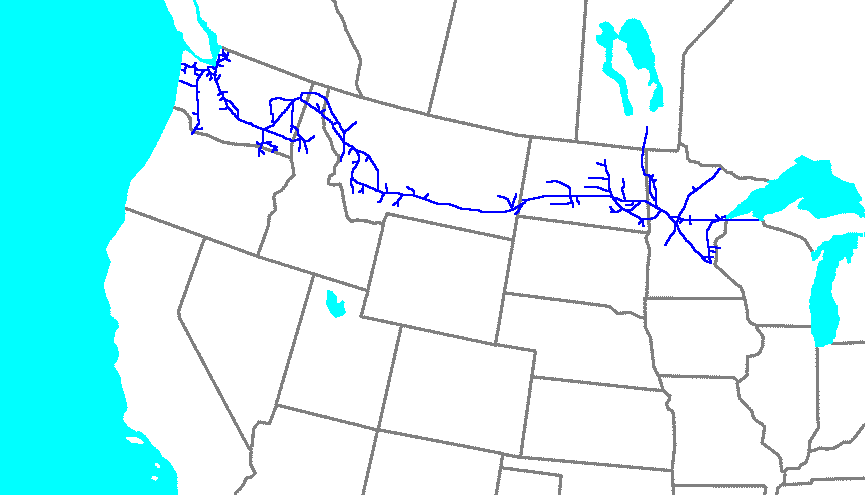|
Lewistown, Montana
Lewistown is a city in and the county seat of Fergus County, Montana, United States. The population was 5,952 at the 2020 census. Lewistown is located in the geographic center of the state, southeast of Great Falls and northwest of Billings. First planned in 1882, it was the site of an 1880s gold rush, and served as an important railway destination, supplying surrounding communities with bricks via rail. History The area was the territory of the Blackfoot Native Americans. In 1874, Fort Lewis was established there by Company "F" of the 7th U.S. Infantry to provide military protection for people traveling on the Carroll Trail, then the shortest route between Carroll, Montana and Helena. Lewistown is named after this fort. The first permanent settlers of Lewistown were Métis. The Metis established Lewistown in 1879. Pierre Berger is credited with being the founder of Lewistown. Berger, along with his wife Judith Wilkie Berger, son Isadore Berger, Isaie Berger, Jean Baptiste Ber ... [...More Info...] [...Related Items...] OR: [Wikipedia] [Google] [Baidu] |
City
A city is a human settlement of notable size.Goodall, B. (1987) ''The Penguin Dictionary of Human Geography''. London: Penguin.Kuper, A. and Kuper, J., eds (1996) ''The Social Science Encyclopedia''. 2nd edition. London: Routledge. It can be defined as a permanent and densely settled place with administratively defined boundaries whose members work primarily on non-agricultural tasks. Cities generally have extensive systems for housing, transportation, sanitation, utilities, land use, production of goods, and communication. Their density facilitates interaction between people, government organisations and businesses, sometimes benefiting different parties in the process, such as improving efficiency of goods and service distribution. Historically, city-dwellers have been a small proportion of humanity overall, but following two centuries of unprecedented and rapid urbanization, more than half of the world population now lives in cities, which has had profound consequences for g ... [...More Info...] [...Related Items...] OR: [Wikipedia] [Google] [Baidu] |
Helena, Montana
Helena (; ) is the capital city of Montana, United States, and the county seat of Lewis and Clark County. Helena was founded as a gold camp during the Montana gold rush, and established on October 30, 1864. Due to the gold rush, Helena would become a wealthy city, with approximately 50 millionaires inhabiting the area by 1888. The concentration of wealth contributed to the city's prominent, elaborate Victorian architecture. At the 2020 census Helena's population was 32,091, making it the fifth least populous state capital in the United States and the sixth most populous city in Montana. It is the principal city of the Helena Micropolitan Statistical Area, which includes all of Lewis and Clark and Jefferson counties; its population is 83,058 according to the 2020 Census. The local daily newspaper is the ''Independent Record''. The city is served by Helena Regional Airport (HLN). History The Helena area was long inhabited by various indigenous peoples. Evidence from the McH ... [...More Info...] [...Related Items...] OR: [Wikipedia] [Google] [Baidu] |
Lewistown Municipal Airport
Lewistown Municipal Airport is two miles southwest of Lewistown, in Fergus County, Montana. It is owned by the city and county. Federal Aviation Administration records say the airport had 596 passenger boardings (enplanements) in calendar year 2008, 1,049 in 2009 and 704 in 2010. The National Plan of Integrated Airport Systems for 2011–2015 called it as a ''general aviation'' airport (the ''commercial service'' category requires 2,500 enplanements per year). Scheduled air service temporarily ceased on March 8, 2008, when Big Sky Airlines ended operations in bankruptcy. Great Lakes Airlines was given USDOT approval to take over Essential Air Service (EAS) and flights began in 2009. Service was provided under EAS contract by Silver Airways (formerly Gulfstream International Airlines) until July 2013. EAS subsidies were terminated on July 15, 2013 due to subsidy per passenger exceeding $1000, leaving Lewistown without scheduled air service. History Lewistown Army Airfield ... [...More Info...] [...Related Items...] OR: [Wikipedia] [Google] [Baidu] |
Boeing B-17 Flying Fortress
The Boeing B-17 Flying Fortress is a four-engined heavy bomber developed in the 1930s for the United States Army Air Corps (USAAC). Relatively fast and high-flying for a bomber of its era, the B-17 was used primarily in the European Theater of Operations and dropped more bombs than any other aircraft during World War II. It is the third-most produced bomber of all time, behind the four-engined Consolidated B-24 Liberator and the multirole, twin-engined Junkers Ju 88. It was also employed as a transport, antisubmarine aircraft, drone controller, and search-and-rescue aircraft. In a USAAC competition, Boeing's prototype Model 299/XB-17 outperformed two other entries but crashed, losing the initial 200-bomber contract to the Douglas B-18 Bolo. Still, the Air Corps ordered 13 more B-17s for further evaluation, then introduced it into service in 1938. The B-17 evolved through numerous design advances but from its inception, the USAAC (later, the USAAF) promoted the aircraft a ... [...More Info...] [...Related Items...] OR: [Wikipedia] [Google] [Baidu] |
US Army Air Corps
The United States Army Air Corps (USAAC) was the aerial warfare service component of the United States Army between 1926 and 1941. After World War I, as early aviation became an increasingly important part of modern warfare, a philosophical rift developed between more traditional ground-based army personnel and those who felt that aircraft were being underutilized and that air operations were being stifled for political reasons unrelated to their effectiveness. The USAAC was renamed from the earlier United States Army Air Service on 2 July 1926, and was part of the larger United States Army. The Air Corps became the United States Army Air Forces (USAAF) on 20 June 1941, giving it greater autonomy from the Army's middle-level command structure. During World War II, although not an administrative echelon, the Air Corps (AC) remained as one of the combat arms of the Army until 1947, when it was legally abolished by legislation establishing the United States Department of the Air Fo ... [...More Info...] [...Related Items...] OR: [Wikipedia] [Google] [Baidu] |
World War II
World War II or the Second World War, often abbreviated as WWII or WW2, was a world war that lasted from 1939 to 1945. It involved the vast majority of the world's countries—including all of the great powers—forming two opposing military alliances: the Allies and the Axis powers. World War II was a total war that directly involved more than 100 million personnel from more than 30 countries. The major participants in the war threw their entire economic, industrial, and scientific capabilities behind the war effort, blurring the distinction between civilian and military resources. Aircraft played a major role in the conflict, enabling the strategic bombing of population centres and deploying the only two nuclear weapons ever used in war. World War II was by far the deadliest conflict in human history; it resulted in 70 to 85 million fatalities, mostly among civilians. Tens of millions died due to genocides (including the Holocaust), starvation, ma ... [...More Info...] [...Related Items...] OR: [Wikipedia] [Google] [Baidu] |
Northern Pacific Railway
The Northern Pacific Railway was a transcontinental railroad that operated across the northern tier of the western United States, from Minnesota to the Pacific Northwest. It was approved by Congress in 1864 and given nearly of land grants, which it used to raise money in Europe for construction. Construction began in 1870 and the main line opened all the way from the Great Lakes to the Pacific when former President Ulysses S. Grant drove in the final "golden spike" in western Montana on September 8, 1883. The railroad had about of track and served a large area, including extensive trackage in the states of Idaho, Minnesota, Montana, North Dakota, Oregon, Washington, and Wisconsin. In addition, the NP had an international branch to Winnipeg, Manitoba, Canada. The main activities were shipping wheat and other farm products, cattle, timber, and minerals; bringing in consumer goods, transporting passengers; and selling land. The Northern Pacific was headquartered in Minnesota, fir ... [...More Info...] [...Related Items...] OR: [Wikipedia] [Google] [Baidu] |
Lombard, Montana
Lombard is a ghost town in southeastern Broadwater County, Montana, Broadwater County, Montana, United States. The town was located on the east bank of the Missouri River, just north of the mouth of Sixteen Mile Creek (Montana), Sixteen Mile Creek. Lombard was established in 1895 as the western terminus of the Montana Railroad, and the location of its interchange with the Northern Pacific Railway. In 1908, the Montana Railroad was incorporated into the new transcontinental main line of the Chicago, Milwaukee, St. Paul and Pacific Railroad ("the Milwaukee Road"). This lessened Lombard's importance as a railroad operational base, but the town survived as an interchange point between the Milwaukee and the Northern Pacific. Lombard was named for A.G. Lombard, the chief engineer of the Montana Railroad. The town's post office was first opened in 1896, and closed in 1957. The population of Lombard declined throughout the first half of the twentieth century, corresponding with its ... [...More Info...] [...Related Items...] OR: [Wikipedia] [Google] [Baidu] |
Montana Railroad
The Montana Railroad was an American railroad built and operated between the towns of Lombard and Lewistown, Montana, a distance of approximately 157 miles. The railroad connected with the national railway network via a connection with the Northern Pacific Railway at Lombard. The Montana Railroad line was constructed between 1895 and 1903, and operated independently until 1908, when it was acquired by the Chicago, Milwaukee, St. Paul and Pacific Railroad ("the Milwaukee Road"). The railroad was colloquially known as "the Jawbone", because of the contrast between the promising statements of the line's promoters and the company's perennially-weak financial position. History The Montana Railroad was the brainchild of Richard A. Harlow, a Helena, Montana attorney and entrepreneur, who envisioned the construction of a railway eastward from Helena to serve the mining and agricultural regions of central Montana. His first attempt at such a project, the Montana Midland, began construc ... [...More Info...] [...Related Items...] OR: [Wikipedia] [Google] [Baidu] |
Judith Mountains
The Judith Mountains are located in central Montana in the Central Montana Alkalic Province in Fergus County, just to the northeast of Lewistown, Montana. Judith Peak is the highest summit of this range, with an elevation of . History To the southeast of Judith Peak lies the remains of Fort Maginnis. Fort Maginnis was built in 1880 to protect the cattle ranches, the gold mining camps in and around the Judith Mountains and the Carroll Trail. The fort was constructed following the battle of the Little Bighorn. In 1879, Granville Stuart and his friend Samuel T. Hauser along with Helena banker Andrew J. Davis established the ''Davis, Hauser and Stuart'' (DHS) cattle company. Stuart was made the general manager of the DHS brand and Stuart located the ranch headquarters on on the southern slopes of the Judith Mountains near Flat Willow Creek. The DHS Ranch was one of the largest open range cattle operations in the Central Montana prairie in the 1880s. Mining and geology The geo ... [...More Info...] [...Related Items...] OR: [Wikipedia] [Google] [Baidu] |







